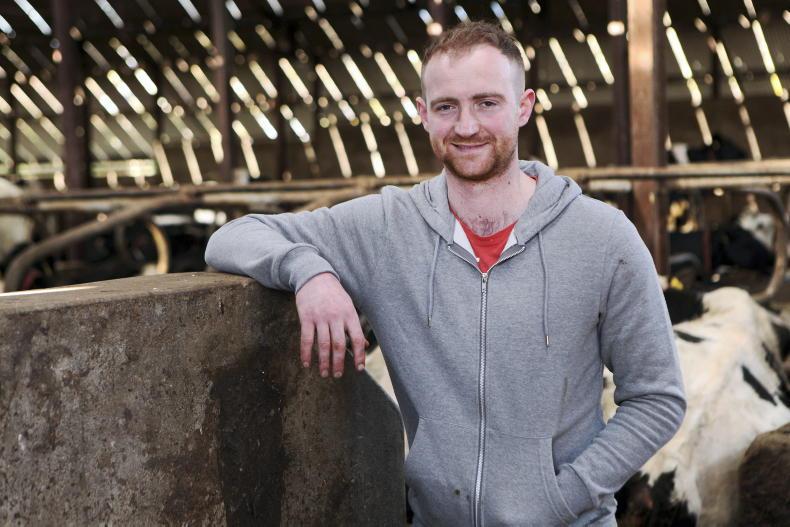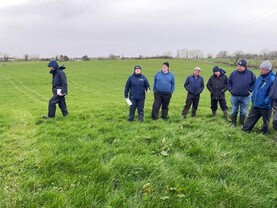With the third cut safely ensiled in good conditions, silage season is now complete on the Dromintee farm of James and Owen Martin in south Armagh.
According to James, the third cut was harvested on 2 August, and with silage pits well filled, he has no plans to take a further cut, other than some bales if grass gets ahead of grazing livestock.
Following the third cut, the sward received 1,500 gallons per acre (17m3/ha) of slurry, along with one bag per acre (approximately 27 units per acre) of straight nitrogen fertiliser. It is now being grazed by replacement heifers.

Dairylink participant James Martin. \ Houston Green
With regrowths good, James would like to keep heifers out well into the autumn, although that will be dictated by prevailing weather conditions. Heifer replacements under six months are getting 1kg/head of concentrate at grass, with older heifers on a grass-only diet.
Given the fragmented nature of the farm and lack of grazing around the yard, the milking herd is housed year-round. As a result, silage quality is crucial if feed costs are to be kept under control.
Harvested
The first cut was harvested in the third week of May, with the second cut ensiled around the end of June. As shown in Table 1, silage quality is good, with ME content of both silages above 11MJ/kg of dry matter.
Dry matter is only slightly below the target of 25%-30%, while the pH of both is within the ideal range of 3.8-4.2, indicating that a stable fermentation has taken place.
Sometimes in wetter silages with high sugar contents, pH can be driven down below 3.6, and this can have a negative impact on subsequent intake.
In very dry silages above 35% dry matter, there is less moisture available for the fermentation process, so a pH above 4 is common. The main issue with these silages is that they are more prone to spoilage at feeding out.
The other notable issue with the Martin’s silage is quite a high protein content, particularly in the first-cut silage, of 15.6%. The protein content is dictated by the growth stage of the plant pre-cutting, and as grass matures, protein goes down. High-quality, leafy grass should have a crude protein around 16%.
The other main factor dictating protein content is fertiliser nitrogen. If insufficient nitrogen is applied, it will result in low protein silages below 12%.
But over-application runs the risk that the silage will have a higher buffering capacity, meaning the target pH of 3.8-4.2 is more difficult to achieve, and a bad fermentation results. In this scenario, wilting to around 30% DM is vital.
Options
Having good-quality silage in the pits gives farmers more options when it comes to formulating rations for milking cows, says Dairylink CAFRE adviser Michael Garvey.
“Where the silage protein content is above 15%, there is the potential to take out some cost by feeding a lower protein ration.
“But James and Owen include caustic wheat into their TMR, so in their case, that probably limits their ability to feed a lower protein nut,” maintains Michael.
At present, the Martin’s rolling average milk yield stands at 9,364l per cow, on an average of 3.47t concentrate per cow per year.
Reseeding using minimal cultivation
Over the last number of years, the Martins have preferred to reseed grassland using minimal cultivation techniques as opposed to ploughing.
Avoiding ploughing means that costs are reduced, while there are also obvious benefits to not turning over stony land. The other main issue with ploughing is that in many instances, it is done too deeply, with the most fertile soil buried below the surface.
Where an existing sward is reasonably open (eg frequently cut for silage), it may be possible to go in with a couple of runs of a power harrow after a silage cut to create a suitable seed bed.
In this situation, tetraploid grasses work best, as they tend to have a larger seed and more aggressive growth to compete with the existing sward.
However, in most minimal cultivation situations, it is still necessary to burn off the old sward before reseeding 10 to 14 days later. If there is minimal trash on the surface, the seed can be direct drilled. Alternatively, do two to three runs of a power harrow, roll, sow the seed and roll again.
Where the field is burned off, there will be decaying matter on the surface, which releases acids that could inhibit seed germination. Lime should be applied to neutralise this effect.
The Martins plan to reseed 12ac in the coming days using minimal cultivation techniques. The seed mixture to be used includes three varieties on the Pasture Profit Index recommended list – Nashota (tetraploid), Xenon (tetraploid) and Drumbo (diploid).
Read more
Yields approach 10,000l in Armagh
Building grass covers in Antrim
With the third cut safely ensiled in good conditions, silage season is now complete on the Dromintee farm of James and Owen Martin in south Armagh.
According to James, the third cut was harvested on 2 August, and with silage pits well filled, he has no plans to take a further cut, other than some bales if grass gets ahead of grazing livestock.
Following the third cut, the sward received 1,500 gallons per acre (17m3/ha) of slurry, along with one bag per acre (approximately 27 units per acre) of straight nitrogen fertiliser. It is now being grazed by replacement heifers.

Dairylink participant James Martin. \ Houston Green
With regrowths good, James would like to keep heifers out well into the autumn, although that will be dictated by prevailing weather conditions. Heifer replacements under six months are getting 1kg/head of concentrate at grass, with older heifers on a grass-only diet.
Given the fragmented nature of the farm and lack of grazing around the yard, the milking herd is housed year-round. As a result, silage quality is crucial if feed costs are to be kept under control.
Harvested
The first cut was harvested in the third week of May, with the second cut ensiled around the end of June. As shown in Table 1, silage quality is good, with ME content of both silages above 11MJ/kg of dry matter.
Dry matter is only slightly below the target of 25%-30%, while the pH of both is within the ideal range of 3.8-4.2, indicating that a stable fermentation has taken place.
Sometimes in wetter silages with high sugar contents, pH can be driven down below 3.6, and this can have a negative impact on subsequent intake.
In very dry silages above 35% dry matter, there is less moisture available for the fermentation process, so a pH above 4 is common. The main issue with these silages is that they are more prone to spoilage at feeding out.
The other notable issue with the Martin’s silage is quite a high protein content, particularly in the first-cut silage, of 15.6%. The protein content is dictated by the growth stage of the plant pre-cutting, and as grass matures, protein goes down. High-quality, leafy grass should have a crude protein around 16%.
The other main factor dictating protein content is fertiliser nitrogen. If insufficient nitrogen is applied, it will result in low protein silages below 12%.
But over-application runs the risk that the silage will have a higher buffering capacity, meaning the target pH of 3.8-4.2 is more difficult to achieve, and a bad fermentation results. In this scenario, wilting to around 30% DM is vital.
Options
Having good-quality silage in the pits gives farmers more options when it comes to formulating rations for milking cows, says Dairylink CAFRE adviser Michael Garvey.
“Where the silage protein content is above 15%, there is the potential to take out some cost by feeding a lower protein ration.
“But James and Owen include caustic wheat into their TMR, so in their case, that probably limits their ability to feed a lower protein nut,” maintains Michael.
At present, the Martin’s rolling average milk yield stands at 9,364l per cow, on an average of 3.47t concentrate per cow per year.
Reseeding using minimal cultivation
Over the last number of years, the Martins have preferred to reseed grassland using minimal cultivation techniques as opposed to ploughing.
Avoiding ploughing means that costs are reduced, while there are also obvious benefits to not turning over stony land. The other main issue with ploughing is that in many instances, it is done too deeply, with the most fertile soil buried below the surface.
Where an existing sward is reasonably open (eg frequently cut for silage), it may be possible to go in with a couple of runs of a power harrow after a silage cut to create a suitable seed bed.
In this situation, tetraploid grasses work best, as they tend to have a larger seed and more aggressive growth to compete with the existing sward.
However, in most minimal cultivation situations, it is still necessary to burn off the old sward before reseeding 10 to 14 days later. If there is minimal trash on the surface, the seed can be direct drilled. Alternatively, do two to three runs of a power harrow, roll, sow the seed and roll again.
Where the field is burned off, there will be decaying matter on the surface, which releases acids that could inhibit seed germination. Lime should be applied to neutralise this effect.
The Martins plan to reseed 12ac in the coming days using minimal cultivation techniques. The seed mixture to be used includes three varieties on the Pasture Profit Index recommended list – Nashota (tetraploid), Xenon (tetraploid) and Drumbo (diploid).
Read more
Yields approach 10,000l in Armagh
Building grass covers in Antrim







 This is a subscriber-only article
This is a subscriber-only article










SHARING OPTIONS: